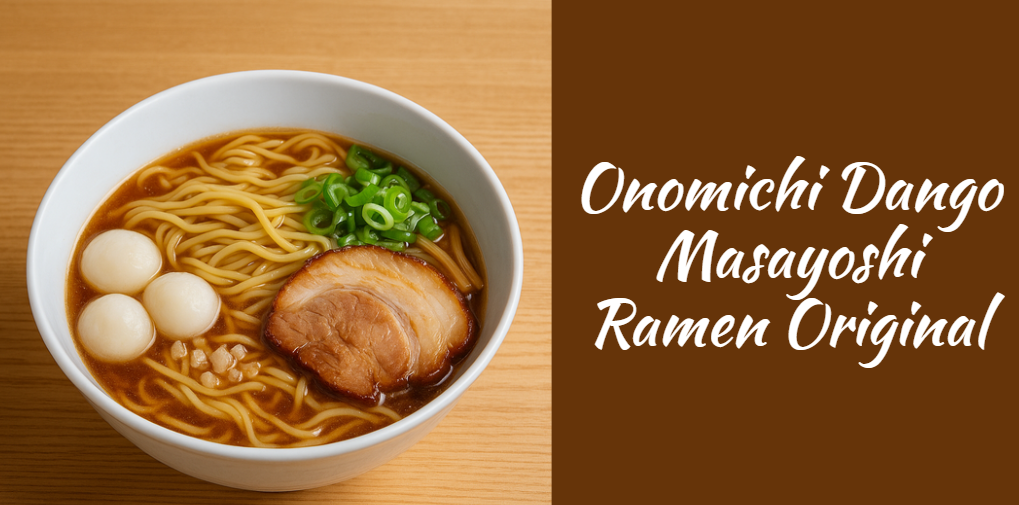Discover the Unique Flavors of Onomichi Dango Masayoshi Ramen Original
Onomichi Dango Masayoshi Ramen Original is more than just a noodle dish – it is a culinary story woven through tradition, innovation, and a love for bold flavors. Originating from Onomichi, a charming city in Japan’s Hiroshima Prefecture, this dish merges the savory depth of ramen with the soft chewiness of dango, creating a unique eating experience that has caught the attention of food lovers both in Japan and around the world.
This fusion dish is credited to a creative local chef named Masayoshi, who dared to combine two iconic Japanese favorites – ramen and dango. The result is a delicious balance of rich broth, firm noodles, sweet-salty rice dumplings, and traditional toppings.
Historical Background
The roots of Onomichi Dango Masayoshi Ramen Original lie deep in the culinary traditions of Onomichi, a port town known for its beautiful hillside views and street food culture. Ramen itself has long been a staple in Onomichi, particularly versions using soy-based broths enhanced with seafood elements like sardines.
The name “Masayoshi” comes from the chef who pioneered this dish in the mid-to-late 20th century. Inspired by local tastes and seasonal ingredients, Masayoshi sought to bring together comforting textures and flavors. He chose to add dango – traditionally a sweet treat – into a savory ramen broth. This innovation was initially met with curiosity, but soon became beloved for its surprising harmony of taste and texture.
Over the years, the Onomichi Dango Masayoshi Ramen Original evolved into a local delicacy, especially celebrated during food festivals and at ramen-focused eateries in the region.
Key Ingredients
To appreciate the distinctiveness of this dish, it’s important to understand its ingredients. Each element is thoughtfully chosen to balance flavor, aroma, and texture.
| Component | Ingredients | Function in Dish |
|---|---|---|
| Broth | Dried sardines, kombu, soy sauce, pork bones | Provides umami base with seafood depth |
| Noodles | Flat, hand-cut, wheat-based | Offers chewiness that complements the broth |
| Dango | Glutinous rice flour, water | Adds softness and a mild sweetness |
| Toppings | Chashu pork, green onions, bamboo shoots | Enhances flavor and visual appeal |
| Garnish | Pork back fat, sometimes nori or sesame | Adds richness and final taste balance |
Each ingredient is crucial in shaping the final taste. While ramen usually leans toward savory, the addition of dango introduces a gentle sweetness that’s subtle yet impactful.
Preparation Techniques
Creating an authentic bowl of Onomichi Dango Masayoshi Ramen Original requires patience and precision. Each step in the process contributes to its final flavor.
The broth is typically made by simmering pork bones, dried sardines (niboshi), and kombu for hours. This slow cooking process allows the flavors to meld and create a deeply satisfying umami base. The soy sauce is added later to maintain its fragrance and richness.
The noodles, flat and slightly chewy, are handmade using wheat flour and salt water. They are rolled and cut into ribbons, then lightly boiled to retain firmness.
Dango, made from glutinous rice flour mixed with water, is shaped into small balls and boiled until soft. Unlike dessert dango, this version is unsweetened or only mildly sweet, so it doesn’t overpower the broth.
Once each component is ready, the bowl is assembled by layering the broth first, followed by noodles, then placing the dango gently. The toppings are then arranged for both flavor and aesthetic appeal.
Flavor Profile
The unique flavor profile of Onomichi Dango Masayoshi Ramen Original is one of the main reasons for its growing popularity. The broth stands out with a savory, slightly briny taste from the sardines and kombu. The soy sauce adds depth and a slightly sweet, fermented tang.
The noodles, being flat and firm, absorb the broth well, offering a satisfying bite. The dango introduces an unexpected softness and a gentle sweetness that contrasts beautifully with the other savory ingredients.
When topped with tender slices of chashu pork and crunchy bamboo shoots, every spoonful becomes a combination of textures – chewy, tender, and soft. It’s a comforting and exciting meal that delights the senses.
Cultural Significance
This ramen is not just about flavor; it’s a symbol of culinary creativity in Onomichi. It reflects how traditional Japanese cuisine continues to evolve by blending contrasting elements into something greater than the sum of its parts.
The dish is often served during local events such as the Onomichi Ramen Festival, where visitors get to explore various ramen innovations. For locals, Onomichi Dango Masayoshi Ramen Original is a point of pride – a fusion that represents the town’s willingness to experiment while staying true to tradition.
Variations and Modern Interpretations
While the original recipe remains a classic, several modern versions have emerged, catering to different palates and dietary preferences.
Popular Variations Include:
- Spicy Miso Masayoshi Ramen:
Adds chili oil and fermented miso paste to create a bold and spicy twist on the original. - Vegan Dango Ramen:
Replaces the meat-based broth with a rich mushroom and seaweed dashi, and includes tofu as a topping. - Sweet-Savory Dessert Ramen:
A playful spin featuring lightly sweetened broth, fruit-topped dango, and soy-milk noodles for a dessert experience.
These interpretations show how versatile the core idea of Onomichi Dango Masayoshi Ramen Original can be.
Where to Experience It
If you want to enjoy this dish in its birthplace, there are several renowned spots in Onomichi:
- Masayoshi Ramen House – The original home of the dish.
- Ramen Kaido – Famous for local-style ramen with creative twists.
- Onomichi Ramen Festival (October) – A great event to try many styles of this dish in one place.
Outside of Japan, select Japanese restaurants in cities like New York, London, and Paris are starting to offer their own versions of this ramen as global curiosity grows.
Cooking at Home
Making Onomichi Dango Masayoshi Ramen Original at home is achievable with the right ingredients and some preparation.
Ingredients You’ll Need:
- Dried sardines, kombu, soy sauce, pork bones (for broth)
- Wheat flour, water, salt (for noodles)
- Glutinous rice flour (for dango)
- Chashu pork, green onions, bamboo shoots (for toppings)
Basic Cooking Steps:
- Simmer pork bones, sardines, and kombu for 6–8 hours to make the broth.
- Prepare noodles by kneading and cutting the dough into flat strips.
- Shape and boil the dango until they float.
- Assemble the dish with broth first, then noodles, dango, and toppings.
Tips:
- Freeze dango before boiling to help them hold shape.
- Let the broth sit overnight for a deeper flavor.
- Use fresh toppings to preserve texture and taste.
Conclusion
Onomichi Dango Masayoshi Ramen Original is a delicious example of Japanese culinary evolution. It combines the earthy, comforting nature of ramen with the smooth texture and subtle sweetness of dango to deliver a truly unique meal.
Whether you’re a ramen enthusiast, a culinary explorer, or just someone looking for a comforting yet adventurous dish, this ramen offers an unforgettable experience. If you ever get the chance to try it – whether in Onomichi or at home – don’t miss the opportunity to enjoy this one-of-a-kind bowl.
Recommended Articles
Understanding Source Address 5910d068: A Comprehensive Guide to Networking and Security
AWT69X Technology: Full Guide to Features, Architecture, Applications & Future
The Story of Susanne Capurso and 302 Spring Drive, East Meadow
Orannalaura: A Comprehensive Guide to Its Meaning, Influence and Multifaceted Role in Modern Culture





